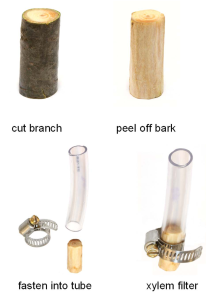
Image from Paper
On Episode 14 of LASER we discuss using tree branches as water filters, a new type of super-thin room temperature infrared light detector that uses graphene, and the $1 Origami Microscope.
4:05 The article in Popular Mechanics titled “A simple tree branch can become a backyard water filter” and the FREE paper in PLOS One “Water Filtration Using Plant Xylem”
5:50 The idea is to help the developing world by testing a cheap water filter that only requires a tree branch and a tube
9:00 its really great when high school students get involved with university research projects and end up publishing papers! If you’re in high school you should talk to a university professor about helping out with a research project a couple of days after class. Even if you don’t plan to study science! (why would you not plan to study science?!)
12:00 Alex joins the group for the discussion! Unfortunately he hasn’t read any of the papers…
23:15 from Motherboard.vice.com we are talking about “infrared imaging may be coming to contact lens near you” and the article “Graphene photodetectors with ultra-broadband and high responsivity at room temperature”
24:30 the article is fine, but I don’t like the headline, and I think that the author of the paper somewhat misrepresented their results to the press.
25:45 a typical infrared detector is this Superconducting Edge Detector (or Transition Edge Bolometer) https://en.wikipedia.org/wiki/Transition_edge_sensor
27:00 Alex asks a good question about the superconducting principle behind how a transition edge sensor works.
35:40 Alex thinks his eyes are bizarre
38:42 the story is found in the MIT Technology Review and is “The $1 Origami Microscope”
41:00 there was a TEDx talk about this a few years ago, when it was a $0.50 cent microscope! Since that time, it costs more because they have developed methods for brightfield and darkfield imaging, and that required a few additional parts.
45:40 We talk about roll-to-roll processing and calendaring of green ceramics. These are manufacturing techniques for many materials.
48:05 Cameron said you can’t re-crystallize Al2O3 from amorphous to crystalline forms, but that is WRONG! http://link.springer.com/article/10.1007/BF00774113
Links to purchase the music used in this week’s episode:
Intro: Open – Crying (Get Olde)
Picture of a Tree That Doesn’t Look Okay – The World Is a Beautiful Place & I am No Longer Afraid to Die
Amoeba – The Adolescents
Outro: Dreams are Maps – The Wild (Dreams are Maps)
Podcast: Play in new window | Download
Subscribe: Apple Podcasts | RSS







Enjoyed this podcast. Would it be possible to announce what papers you will be discussing a week or so before the show? That way we could read them ahead and have a little more knowledge. Of course maybe they aren’t all available online. I’m still getting caught up on the past shows. There was one where you started to explain ‘noise cancelling headphones’ but didn’t go into much detail. I would be interested to know how they work. Maybe you could do a regular segment explaining an everyday device and how it works, like the headphones. I like the music and was blown away by Alex’s mouth jazz. smiles. Bonnie
Thanks Bonnie!
Most of the papers we talk about are behind a pay wall, so it would be a little difficult for people without university access to read them. I think we might be able to send out a list of the references to people who wanted it though, I’ll talk to the group and see how we should do that. I’d be a little concerned about “spoiling” the episode though, since not everyone wants to know ahead of time, so it may be an opt-in thing somehow.
-Cameron